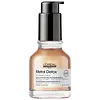What's inside
What's inside
 Key Ingredients
Key Ingredients

 Benefits
Benefits

 Concerns
Concerns

 Ingredients Side-by-side
Ingredients Side-by-side

Isododecane
EmollientWater
Skin ConditioningDipropylene Glycol
HumectantDimethicone
EmollientAlcohol Denat.
AntimicrobialDimethiconol
EmollientGlycerin
HumectantPEG-14 Dimethicone
Skin ConditioningHydroxyethyl Urea
HumectantPhenoxyethanol
PreservativePEG-60 Hydrogenated Castor Oil
EmulsifyingLimonene
PerfumingPolyacrylamide
C13-14 Isoparaffin
EmollientPropylene Glycol
HumectantHexyl Cinnamal
PerfumingLinalool
PerfumingLaureth-7
EmulsifyingCaramel
Cosmetic ColorantCitral
PerfumingGlycine
BufferingGeraniol
PerfumingCoumarin
PerfumingCI 19140
Cosmetic ColorantPolyquaternium-7
CI 15985
Cosmetic ColorantPentaerythrityl Tetra-Di-T-Butyl Hydroxyhydrocinnamate
AntioxidantSodium Benzoate
MaskingParfum
MaskingIsododecane, Water, Dipropylene Glycol, Dimethicone, Alcohol Denat., Dimethiconol, Glycerin, PEG-14 Dimethicone, Hydroxyethyl Urea, Phenoxyethanol, PEG-60 Hydrogenated Castor Oil, Limonene, Polyacrylamide, C13-14 Isoparaffin, Propylene Glycol, Hexyl Cinnamal, Linalool, Laureth-7, Caramel, Citral, Glycine, Geraniol, Coumarin, CI 19140, Polyquaternium-7, CI 15985, Pentaerythrityl Tetra-Di-T-Butyl Hydroxyhydrocinnamate, Sodium Benzoate, Parfum
C13-15 Alkane
SolventCoco-Caprylate
EmollientEthylhexyl Olivate
Skin ConditioningUndecane
EmollientTridecane
PerfumingSclerocarya Birrea Seed Oil
HumectantJojoba Esters
EmollientSqualane
EmollientPlukenetia Volubilis Seed Oil
EmollientSalvia Hispanica Seed Oil
MoisturisingTocopherol
AntioxidantTetrahexyldecyl Ascorbate
AntioxidantEclipta Prostrata Extract
Skin ConditioningMelia Azadirachta Leaf Extract
Skin ConditioningMoringa Oleifera Seed Oil
EmollientGlycine Soja Oil
EmollientBrassica Campestris/Aleurites Fordi Oil Copolymer
Skin ConditioningParfum
MaskingLinalool
PerfumingLimonene
PerfumingEugenol
PerfumingCitronellol
PerfumingCitral
PerfumingC13-15 Alkane, Coco-Caprylate, Ethylhexyl Olivate, Undecane, Tridecane, Sclerocarya Birrea Seed Oil, Jojoba Esters, Squalane, Plukenetia Volubilis Seed Oil, Salvia Hispanica Seed Oil, Tocopherol, Tetrahexyldecyl Ascorbate, Eclipta Prostrata Extract, Melia Azadirachta Leaf Extract, Moringa Oleifera Seed Oil, Glycine Soja Oil, Brassica Campestris/Aleurites Fordi Oil Copolymer, Parfum, Linalool, Limonene, Eugenol, Citronellol, Citral
Ingredients Explained
These ingredients are found in both products.
Ingredients higher up in an ingredient list are typically present in a larger amount.
Citral is a fragrance and used to add a lemon-like scent to products. It is both naturally found in plants and created synthetically. In plants, it is commonly occurring in lemon myrtle, lemongrass, lemon tea-tree, lemon verbena, and other citruses.
The EU mandates Citral be listed separately as a fragrance. It is a known allergen and may cause contact dermatitis. Citral can also used as a masking ingredient.
The term 'fragrance' is not regulated in many countries. In many cases, it is up to the brand to define this term. For instance, many brands choose to label themselves as "fragrance-free" because they are not using synthetic fragrances. However, their products may still contain ingredients such as essential oils that are considered a fragrance.
The term 'citral' is a collective term for two geometric isomers: geranial/Citral A and neral/Citral B.
Learn more about CitralLimonene is a fragrance that adds scent and taste to a formulation.
It's found in the peel oil of citrus fruits and other plants such as lavender and eucalyptus. The scent of limonene is generally described as "sweet citrus".
Limonene acts as an antioxidant, meaning it helps neutralize free radicals.
When exposed to air, oxidized limonene may sensitize the skin. Because of this, limonene is often avoided by people with sensitive skin.
The term 'fragrance' is not regulated in many countries. In many cases, it is up to the brand to define this term. For instance, many brands choose to label themselves as "fragrance-free" because they are not using synthetic fragrances. However, their products may still contain ingredients such as essential oils that are considered a fragrance.
Learn more about LimoneneLinalool is a fragrance and helps add scent to products. It's derived from common plants such as cinnamon, mint, citrus, and lavender.
Like Limonene, this ingredient oxidizes when exposed to air. Oxidized linalool can cause allergies and skin sensitivity.
This ingredient has a scent that is floral, spicy tropical, and citrus-like.
Learn more about LinaloolParfum is a catch-all term for an ingredient or more that is used to give a scent to products.
Also called "fragrance", this ingredient can be a blend of hundreds of chemicals or plant oils. This means every product with "fragrance" or "parfum" in the ingredients list is a different mixture.
For instance, Habanolide is a proprietary trade name for a specific aroma chemical. When used as a fragrance ingredient in cosmetics, most aroma chemicals fall under the broad labeling category of “FRAGRANCE” or “PARFUM” according to EU and US regulations.
The term 'parfum' or 'fragrance' is not regulated in many countries. In many cases, it is up to the brand to define this term.
For instance, many brands choose to label themselves as "fragrance-free" because they are not using synthetic fragrances. However, their products may still contain ingredients such as essential oils that are considered a fragrance by INCI standards.
One example is Calendula flower extract. Calendula is an essential oil that still imparts a scent or 'fragrance'.
Depending on the blend, the ingredients in the mixture can cause allergies and sensitivities on the skin. Some ingredients that are known EU allergens include linalool and citronellol.
Parfum can also be used to mask or cover an unpleasant scent.
The bottom line is: not all fragrances/parfum/ingredients are created equally. If you are worried about fragrances, we recommend taking a closer look at an ingredient. And of course, we always recommend speaking with a professional.
Learn more about Parfum